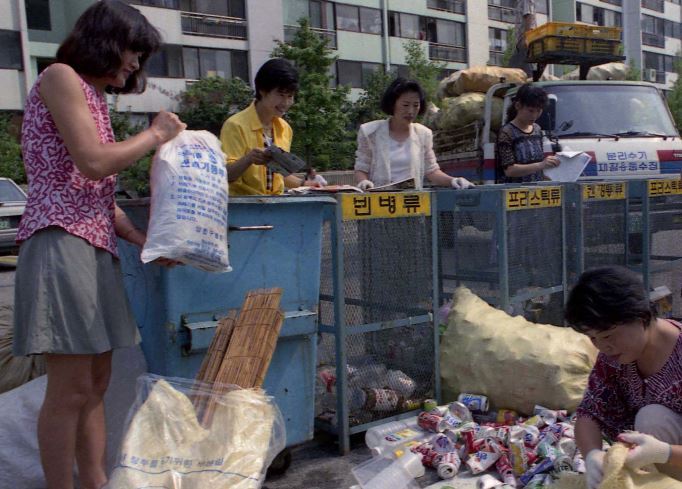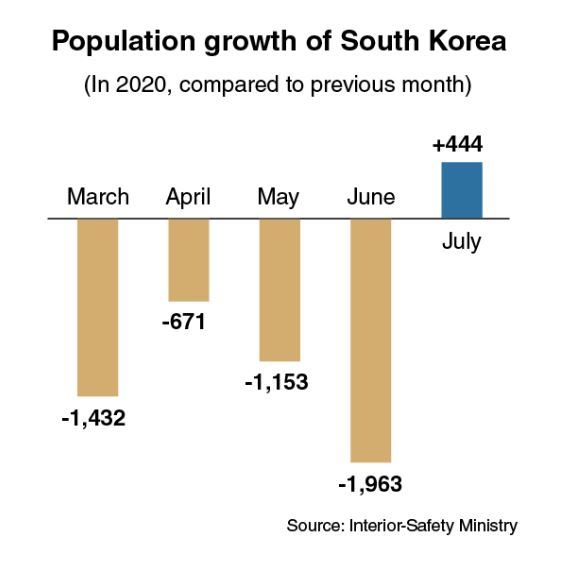[News Focus] Korea gains 444 in population after losing 12,000 for 7 months
Men’s population declines for 12th consecutive month
By Kim Yon-sePublished : Aug. 4, 2020 - 14:42

SEJONG -- South Korea’s population posted a positive growth for the first time in eight months in July, after it suffered a continuous negative growth during the December 2019-June 2020 period.
But the men’s population fell for the 12th consecutive month. This is leading the nation’s population decline, which de facto started in late 2019.
According to the Ministry of Interior and Safety, Korea saw the population inch up 444 (minus 1,141 for men and plus 1,585 for women), compared to the previous month, to reach 51.839 million.
This marked the first increase since the demographic figure recorded plus 722 in November 2019. The population decreased by 12,019 collectively between Dec. 1 and June 30.
However -- despite the rebound -- it is estimated that the figure was down in terms of yearly population, amid the record-low fertility rates and falling marriage rates.
A symptom signaling a continuous drop in the coming months and years is the male population, which fell by 15,842 in total over the past 12 months. Starting from August 2019, the figures for men have continued to post negative growth through July 2020.
As for women, the figures have fluctuated between negative and positive over the past few months on the back of longer lifespan than men among seniors, despite the low birthrates.
Meanwhile, some major cities and provinces suffered a continual losing streak in the number of registered residents last month.

Seoul topped the list the decline ranking among the 17 major areas (eight cities and nine provinces) as the capital posted minus 5,417. The population of Seoul stood at 9.715 million, which is estimated to be the lowest in about 35 years since the mid-1980s.
A certain portion of households in Seoul have had to move to Gyeonggi Province due to skyrocketing apartment prices over the past several years, an effect which is still underway.
Only for the five-month period (March 1-July 31), the number of residents in the capital decreased by 21,533. Compared to five years earlier in July, when the figure reached 10.07 million, Seoul lost about 356,000 in population.
North Gyeongsang Province ranked second in the monthly negative growth with minus 2,492, followed by South Gyeongsang Province with minus 1,817, Incheon with minus 1,652, Busan with minus 1,647 and South Jeolla Province with minus 1,279.
Busan, the nation’s second-largest city, saw its number of residents fall for the 54th consecutive month starting from February 2016 with the figure dropping about 100,000 over the period. Compared to five years earlier, Busan lost more than 116,000 in population.
Among next rankers were Ulsan with minus 828, Daejeon with minus 815, North Jeolla Province with minus 758 and Gwangju with minus 339.
In contrast, the number of residents in Gyeonggi Province, the nation’s most populous area, rose 13,871 to reach an all-time high of 13.35 million.
Other areas, which gained population, included Daegu, Sejong, Jeju Province and South Chungcheong Province.
Last month, the number of births was outstripped by deaths: 23,721 vs. 24,793, which might indicate an “arithmetical” decline in population by 1,072. But immigration and citizenship changes are estimated to have led to an increase.
The Interior Ministry’s data also showed that women outnumbered men by 134,260 -- 25.987 million vs. 25.852 million.
In terms of the tally for centenarians, Seoul outstripped Gyeonggi Province by 6,572 vs. 4,190. The data showed that 30.9 percent of the people aged 100 or over were residing in Seoul as of July.
By Kim Yon-se (kys@heraldcorp.com)







![[From the Scene] Monks, Buddhists hail return of remains of Buddhas](http://res.heraldm.com/phpwas/restmb_idxmake.php?idx=644&simg=/content/image/2024/04/19/20240419050617_0.jpg&u=20240419175937)







![[From the Scene] Monks, Buddhists hail return of remains of Buddhas](http://res.heraldm.com/phpwas/restmb_idxmake.php?idx=652&simg=/content/image/2024/04/19/20240419050617_0.jpg&u=20240419175937)

![[KH Explains] Hyundai's full hybrid edge to pay off amid slow transition to pure EVs](http://res.heraldm.com/phpwas/restmb_idxmake.php?idx=652&simg=/content/image/2024/04/18/20240418050645_0.jpg&u=20240419100350)

![[Today’s K-pop] Illit drops debut single remix](http://res.heraldm.com/phpwas/restmb_idxmake.php?idx=642&simg=/content/image/2024/04/19/20240419050612_0.jpg&u=)